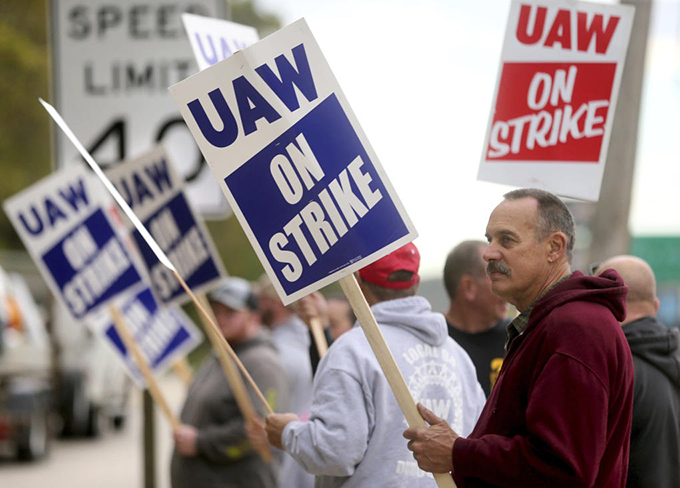It’s a “Movement Moment” In the U.S.
By Peter Olney and Rand Wilson
During the worst moments of the COVID pandemic, employers and the public recognized front-line workers as “essential.” Workers were given special “hero” pins and sometimes hazard pay. But far too often, “essential” did not mean proper safety equipment, or increased dignity and respect on the job.
Since the start of the pandemic nearly 8 million workers left the labor force, according to federal statistics. It’s a phenomenon known as the Great Resignation. So now as employers compete for staff in a tight labor market, wages have risen by about 5.6 percent in the past year.[1]
U.S. workers are discovering their power.
An uptick in private sector strikes at companies like John Deere, Kellogg’s, and Nabisco last fall — termed “Striketober” — indicated renewed willingness by workers to participate in workplace actions. Stephanie Luce, a professor of labor studies at the CUNY School of Labor and Urban Studies observed, “As someone who’s studied labor issues for the last 30 years or so, I’ve never seen anything like it in terms of the level of interest and excitement from people who want to fight back at the workplace.”
And workers are organizing new unions at an unprecedented number of companies. The NLRB is overwhelmed with petitions for union representation elections.[2] Amazon and Starbucks workers have upended the old common sense for how to organize unions.[3] Now is the time for union leaders to retool their organizing tactics to fit a moment when — finally — workers are leading the way.[4][5]
At the time of this writing, workers affiliated with Starbucks Workers United have filed for union elections in nearly 300 stores across 35 states and have won more than 150 of them. [6]
As long-time labor organizer Wade Rathke recently noted, “Amazon workers have not only organized in Alabama and New York, they have already won one election and more are pending. Groups like Amazonians United have agitated in another dozen locations on issues inside warehouses, distribution, and delivery centers. Starbucks workers have filed for election in hundreds of stores and are winning most of the elections held to date. Apple retail workers are organizing, as are tech workers at game companies, on-line news platforms, and elsewhere. Google workers have kicked up their heels.”[7]
More than a tight labor market
Workers’ experience in the COVID pandemic, the job resignations, a tight labor market, and the increasing popularity of unions have created the conditions for this “movement moment.” But so has the political context.
US President Joe Biden declared his intent to be the “most pro-union president leading the most pro-union administration in history.”[8] It’s proved to be more than rhetoric. Under the Biden administration, the NLRB is finally protecting employees’ rights to engage in protected concerted activities by issuing 10(J) injunctions.[9] The board has already issued twelve 10(j) injunctions in federal district courts against employers to stop unfair labor practices.[10] The Labor Board’s more aggressive support for workers’ rights has emboldened workers to take action.
A note of caution
Despite so many positive signs for the movement, labor in the US remains relatively weak and faces a number of political and economic challenges. A sobering reminder is that union density has continued its decline. Membership is down to 10.3 percent of the workforce in 2021, from its peak of 35 percent in 1954.[11] Private sector membership is hovering at 6.7 percent, down from a high of 35 percent in 1955.
Will labor take advantage of this “movement moment?”
At its recent convention in June, the AFL-CIO committed to organize one million new workers in ten years.[12] One million per year would be ambitious, but only organizing one million workers over ten years means labor’s density (the percentage of total eligible workers), would continue to drop dramatically.[13]
Ironically while labor’s membership density is dropping, its treasuries are booming. A union researcher has calculated that the labor movement is sitting on a huge multi-billion dollar surplus. Now is the time for unions to spend their money on the massive task of organizing giant corporations like Amazon, Wal-Mart and Starbucks.[14],[15]
However, if these organizing initiatives are to be successful, they will need a strong presence of internal workplace organizers. Unions must cultivate and support young people to take jobs in key industries with the sole purpose of organizing. There is no better experience for recently radicalized socialists than participating in labor’s organizing renaissance than from the ground up.[16]
The national collective bargaining agreement between the Teamsters Union and United Parcel Service covering over 350,000 workers expires on August 1, 2023. Amazon is an existential threat to the wages and workplace standards that Teamsters’ union has negotiated at UPS and many other warehouses and transportation companies. Teamster organizers are urging that the contract campaign (and possible national strike) be tightly linked in support of the workers organizing at Amazon.
UPS Teamster Anthony Rosario, a member of New York Local 804 said, “When Amazon workers see us fighting for a good contract [at UPS], they will have a better understanding of what the labor movement is. And when we win a good contract, we’re helping them too. By taking on UPS, Teamsters will be setting the standard for the entire warehouse and delivery sector. We can show the world what a labor movement really looks like!” [17]
UPS Teamster activists are taking time off to enlist their coworkers at UPS to help Amazon workers’ organize and giving aid and support to Amazon workers who are building their union.[18]
Already workers from the Amazonians United network have engaged in coordinated strike action in geographic areas like the Northeast corridor and Chicagoland. These strikes, while small and short term, are great proving grounds for building solidarity and worker confidence. More strategic strikes are likely in the future at key nodes of the Amazon supply chain.[19]
The midterm elections of 2022 and the quadrennial Presidential election loom large for the future of American democracy. The growth of unions, particularly in key nodes in the economy is one of the best antidotes to the fascist appeals of Donald Trump and his acolytes.[20]
…
[1] “Worker-led win at Amazon warehouse could provide new labor playbook,” by Jacob Bogage, Aaron Gregg and Gerrit De Vynck, Washington Post, April 2, 2022,
[2] “The NLRB is overwhelmed with petitions for union representation elections,” NLRB Office of Public Affairs, April 06, 2022
[3] “Staten Island workers vote ‘yes’ for first Amazon union in U.S.,” by Rand Wilson and Peter Olney, Stansbury Forum, April 6, 2022
[4] “How Amazon and Starbucks Workers Are Upending the Organizing Rules,” Chris Brooks, May 31, 2022
[5] “Three Paths Forward for Labor After Amazon,” by Harmony Goldberg and Erica Smiley, Boston Review June 6, 2022, Boston Review
[7] “A Movement Moment and a Real NLRB,” by Wade Rathke, Working-Class Perspectives, May 9, 2022,
[8] “Remarks by President Biden in Honor of Labor Unions,” SPEECHES AND REMARKS, SEPTEMBER 08, 2021
[9] “Protected Concerted Activity“
[10] “NLRB General Counsel Launches New 10(j) Injunction Initiative When Employers Threaten or Coerce Employees During Organizing Campaigns,” February 01, 2022, NLRB Office of Public Affairs,
[11] “Union membership rate declines in 2021, returns to 2019 rate of 10.3 percent,” Bureau of Labor Statistics, U.S. Department of Labor, The Economics Daily, January 25, 2022.
[12] “AFL-CIO committed to organize one million new workers in ten years,” Ian Kullgren, Daily Labor Report, Bloomberg Law, June 13, 2022
[13] “The AFL-CIO’s Official New Goal: Continued Decline,” HAMILTON NOLAN, In These Times, JUNE 14, 2022
[14] “Now Is the Time for Unions to Go on the Offensive,” by CHRIS BOHNER, Jacobin
[15] “AFL-CIO Budget Is a Stark Illustration of the Decline of Organizing,” By Hamilton Nolan, Splinter, May 16, 2019
[16] “Socialists Can Seize the Moment at Amazon,” Jacobin Magazine, , and a second suggestion for young socialists in 2020, “Amazon Workers Desperately Need an Insurgent Union Campaign,” Jacobin Magazine
[17] “THE UPS CONTRACT AND ORGANIZING AMAZON“, Teamsters for a Democratic Union, JUNE 24, 2022
[18] “HOW WORKING TEAMSTERS ARE HELPING ORGANIZE AMAZON,” Teamsters for a Democratic Union, JUNE 24, 2022, and TEAMSTER AMAZON ORGANIZERS SPEAK OUT, Teamsters for a Democratic Union, JUNE 24, 2022
From volunteer organizing to solidarity rallies, members are stepping up to meet the Amazon challenge.
[20] “Winning Back The Factory Towns That Made Trumpism Possible,” by Mike Lux, Jun 7, 2022


